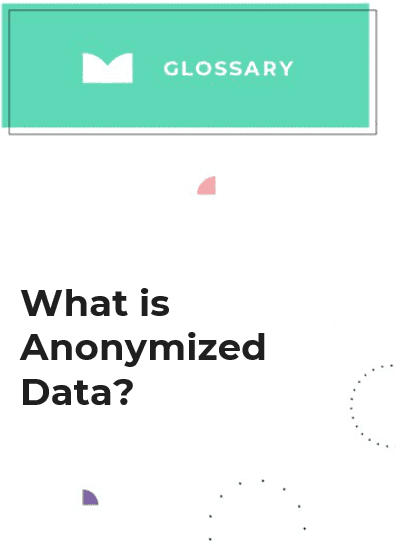
Anonymized Data
Anonymized data is becoming increasingly important for businesses and researchers since it allows you to access a goldmine of insights without compromising anyone’s privacy.
The core techniques of data anonymization involve removing obviously identifying details like names, addresses, social security numbers, and anything that clearly points to one person. But data anonymization also requires removing or altering data that could potentially be combined with other data to identify individuals through inference.
In this post, we clarify the meaning of “anonymized data”, look at some common techniques used to anonymize data, and list some benefits and disadvantages you’ll face when stripping data of personally identifiable information (PII).
What is Anonymized Data?
Anonymized data is data where all private, personal information has been removed using various methods like data masking, pseudonymization, and generalization (we’ll expand on these, below).
Essentially, the goal is to prevent an individual’s identity from being revealed. This is done by stripping out anything that could point back to a specific person. Data anonymization seeks to delicate balance. On one hand, you want to retain enough useful information so that you can gain insight from the data. But you also want to respect people’s right to privacy by removing telltale personal details.
Data Anonymization Example
Ideally, anonymous data lets companies find helpful insights in broader usage and behavior patterns, without exposing sensitive information. Specific names, addresses, ID numbers – anything clearly tied to an individual gets taken out. But details like age, location, and shopping behaviors can stay since they analyze broader trends rather than identify anyone directly.
Here’s are two examples to illustrate that point:
- Anonymized Data Example 1: A retail company wants to analyze customer purchasing data to understand popular products, but they need to anonymize the data first. So, while the raw data would show: John Smith of 123 Main St bought 6 pairs of jeans, the anonymized data would simply show: Customer A is male, aged 30-40, located in the Southwest, and purchased 6 pairs of jeans. The company can still analyze useful patterns – maybe jeans are selling well with males aged 30-40 in Northeastern states. This helps inform their marketing approach without exposing John Smith’s personal identity and address.
- Anonymized Data Example 2: A health organization wants to analyze lifestyle trends tied to heart disease risks. The raw data would have identifiable patient names, addresses, etc. But anonymized, it would track broader insights like: X number of males aged 50-60 with high BMI indexes in the Ohio area display warning signs of heart disease. This allows research for public health goals while respecting personal privacy.
How Do You Anonymize Data?
When anonymizing data, you want to preserve the integrity of the data, but retain enough information that you can draw meaningful insights from it. Part of this process involves protecting and/or obscuring individual identities and sensitive personal information.
Advanced data anonymization tools and dedicated software help navigate this balance responsibly at scale. The six main data anonymization methods are listed below.
1. Data Masking
With data masking, you create a mirror-image version of a database and scramble identifying information – shuffling characters, encrypting data, swapping terms etc. The goal is to obscure data values by inserting symbols like “x” so bad actors can’t easily piece the data back together.
2. Pseudonymization
With this approach, you replace names, numbers, and other identifiers with believable but fake substitutes. For example, you might change “Mark Spencer” to “John Doe.” This lets you use the data while keeping people’s identities secure.
3. Generalization
Generalization makes information less specific by excluding data that can be used to identify someone. For example, you might discard street addresses, but keep city names. The data then becomes less traceable to individuals. Generalization focuses on subtracting just enough unique details to protect privacy, without losing overall accuracy.
4. Data Swapping
Data swapping, also called shuffling or permutation, is a way of obscuring identities by mixing up or changing a specific attribute across the board, like birth date or address. For example, you might randomly reassign actual birth dates across an entire dataset. This makes connecting sensitive attributes to a single person much harder. When attributes like birthdays or locations get shuffled across entries, it strengthens anonymity for the whole dataset.
5. Data Perturbation
This takes the original dataset and modifies it by adding statistical noise, rounding off numbers, swapping for similar values, etc. With data perturbation, the amount of change you introduce should be proportional. That is, not too small and not too big. If the changes are too small (the disturbance is too little), then the data won’t be sufficiently anonymized. If the changes are too big (the disturbance is too much), then the data might lose its usefulness.
6. Synthetic Data
This doesn’t involve modifying existing data. Instead, algorithms are used to create artificial, mock datasets that have no relation to real people. The construction of synthetic data involves using statistical methods like standard deviations, linear regression, and medians to produce synthetic results. This technique is often used when the amount of data being analyzed is too small or insufficient for a given purpose.
Is Anonymous Data Actually Anonymous?
The notion of anonymized data being completely anonymous is somewhat misleading. In certain situations, it’s possible to re-identify individuals from anonymized datasets. Keep in mind that data, even when it’s anonymized, typically retains information like age, birthday, gender, and location. This information could be combined with other datasets to identify an individual.
Anonymization techniques reduce the risk of re-identification, but they can’t entirely eliminate it. So while anonymized data is a valuable tool for protecting privacy, it’s not foolproof. Make sure you adequately understand the risks and benefits when using and sharing this data.
Benefits of Anonymized Data Sharing
Data anonymity offers some compelling upsides for companies. Let’s review the top benefits:
- First, it safeguards customer trust and your market footing. When you lock down personal data, your reputation stays strong. This adherence to data privacy ultimately gives you a competitive edge.
- Next, it helps you comply with data privacy and regulatory laws. Eliminating or masking identifying customer info keeps you compliant with evolving data privacy laws like GDPR and CCPA.
- Additionally, anonymization adds an extra barrier against data theft or internal misuse that could compromise compliance. It reduces overall risk from things like cloud adoption, account compromise, and weak entry points. This is particularly important in data-sensitive industries like healthcare and finance.
- And finally, data anonymity promotes sound data governance. Clean, accurate data lets you leverage analytics without limiting scope or compromising privacy. It’s this pristine data that drives accurate insights which, likewise, drive strategy.
Disadvantages of Anonymized Data Sharing
While there’s no doubt that anonymizing data increases privacy, there are some drawbacks and disadvantages of anonymized data sharing. They include:
- Reduced insights – Scrubbing out personally identifiable details diminishes the precision and analysis potential of your data.
- Imperfect protection – Mathematical re-identification risks remain if methodologies have flaws.
- Expertise required – Performing rigorous anonymization demands specialized expertise and tools, raising time, cost, and complexity.
- Limited suitability – Highly unique small datasets can lack enough masking diversity to stay anonymous.
- Resource intensive – Anonymizing terabytes of data scattered across databases takes substantial data engineering resources.

Why is Anonymous Data Used?
We all walk a delicate line when it comes to leveraging data and maintaining privacy. The wealth of customer and performance data that many companies possess offers a roadmap of intel, but poses huge risks to privacy and security.
Customers rightfully reassurance that their sensitive information isn’t being used irresponsibly or exposed to data breaches. With major regulations like GDPR now enforcing data protections, the stakes are high to handle data conscientiously.
Anonymized data presents a helpful middle ground, allowing you to gain insights and unearth and big-picture patterns without intruding on privacy. That’s good everyone who has a stake in data security – including the individuals who want their data protected, the marketers planning and executing personalized campaigns, and the companies who rely on their data to make data-driven decisions that business growth.

